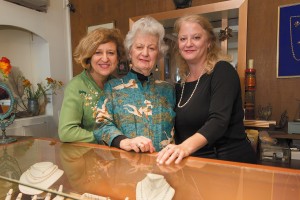Straightening the tortoise shell-rimmed glasses over the bridge of her nose, she eases herself onto the seat in front of her work table and picks up the scalpel with her fair, wrinkled hands to cut the sheet of wax.
She adjusts the red rusting lamp that hovers over the desk, which is cluttered with hand-worn jewelry crafting tools, an antique oil lamp Bunsen burner and travel souvenirs. Her granddaughters smile up at her from the framed photos that are neatly arranged on the corner of her desk.
Muriel Chastanet Fine Jewelry is a family business.
***
The store opened in Westwood almost 50 years ago. Chastanet and her two daughters, who run the store, hand-make jewelry pieces using precious stones and gems, continuing a craft that has been in the family for four generations.
“(Art) is something that touches the spirit – the soul. It has certain qualities,” Chastanet said. “There’s proportion, there’s color, there’s form. Everyone sees with different eyes. What one sees as beautiful may be different to someone else’s eyes.”
Chastanet and her daughter Gizelle Strohkendl craft jewelry in the shop, using a technique known as lost-wax casting, the origins of which can be traced back to as early as the fifth millennium.

Brandon Choe/Daily Bruin senior staff
The process, which is commonly used to make sculptures, involves casting a duplicate metal object from an original model, which in Chastanet’s case is made from wax.
At first, Chastanet said she worked from home, selling handcrafted pieces to galleries and jewelry shops, but realized she needed a professional workspace and decided to set up shop in Westwood in May 1964.
Chastanet said much of her inspiration for her style of design, which is organic with subtle, delicate features, comes from nature – particularly plants, animals or natural objects she sees in her travels abroad.
“I go to the beach and (see) unusual stones and unusual forms of nature,” Chastanet said. “Whatever is unique and beautiful.”
Chastanet comes from a family of jewelers. Her grandfather had a jewelry shop in London and her father had his own jewelry atelier in their Paris home.
Chastanet said while growing up, she recalls being surrounded by beauty, visiting her grandfather’s store and admiring her father’s stunning jewelry pieces.
But jewelry making didn’t pique her interest as much as illustration and fashion. After finishing high school in London, Chastanet studied art in Switzerland and New York in the 1950s.
Chastanet would stop by jewelry boutiques on her way from school in Greenwich Village in New York and admire the contemporary pieces in the window displays.
“I was interested in jewelry as an art form. This is what (jewelry) is – basically sculpture. Jewelry that (can) be worn or displayed,” Chastanet said.
She was an apprentice at a jewelry studio in Sausalito, where she learned the lost wax casting technique and designed and sold crafted jewelry pieces.
Chastanet said she was one of few women who worked in the 1960s, and also was a single mom, struggling to raise her children on her own.
In her early 20s, Chastanet moved to Los Angeles to start her own jewelry business because her pay was not enough to raise her children, she said while slowly adding layers of wax onto a spindly vine – the beginning of a new broach.
There were times when Strohkendl wished her mother could attend after-school activities like other parents, but she was glad to have a working mom in the 1950s and 1960s, she said.
“She was always independent,” Strohkendl said. “She set a great example for us. Things needed to be done and this is what you (had) to do to achieve it, and to do it elegantly in style and beauty.”
Chastanet heated the tool, slowly turned the wax vine and shaped it to form subtle grooves and waves, her long silver rod leading the way.
“It wasn’t that easy, but nothing in life worth having is,” Chastanet said.
***
The Chastanets’ handcrafted jewelry pieces carry special meanings for their customers, most of whom have been regular customers for decades.
Marie Cohen, who has been a client for 38 years, said she remembers when she first pressed her nose against the store window in 1976.
Cohen, a clinical faculty member in the UCLA Department of Psychiatry and Biobehavioral Sciences, was a therapist who had an office across the street from the jewelry store. She would pass by the store during her lunch breaks and admire the pieces in the window display.
“They had unusual designs and semi-precious and precious mineral stones that I had never seen anywhere else. It was this wonderful use of objects (to turn) them into jewelry,” Cohen said.
Cohen’s favorite piece from the shop is her wedding ring.
“Things grow. Your knuckles grow and your earlobes grow (as you age),” Cohen said. “I couldn’t fit the ring on my finger anymore. … Twenty-five years after I got married, I came in and we designed a new wedding ring together.”
Charlotte Chastanet said her sister and mother handcraft one-of-a-kind jewelry for customers.
“(Jewelry) has to have a connection to the wearer. It has to look like it’s made for a human being – not a dummy in a store window,” Muriel Chastanet said.
When asked which jewelry pieces were her favorite, Muriel Chastanet pondered silently before Charlotte Chastanet interrupted, “We’re her two jewels!”
Muriel Chastanet gently embraced her daughter and planted a kiss on her forehead.
